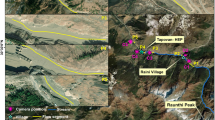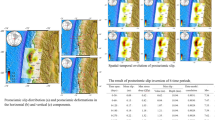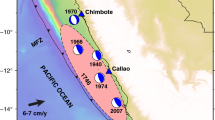Abstract
Before starting seismic cycle of Ahar–Varzaghan 2012 event, a partial gap in the form of a pre-seismic calm sequence (seismicity rate, r = 0.46 event/year, b = 1.4) with duration of 303 days spatially has dominated over the entire seismogenic area. From April 17, 2012, to May 31, 2012, r significantly increased to 2.16, indicating strong foreshock sequence, and b value changed to 1.9, remarkably. In the last two months before the mainshock, foreshocks have partially migrated toward the earthquake fault (with a decrease in size, b = 2.0). Significantly, high rate of seismicity and low V P /V S (1.64) in the foreshocks sequence and also very high seismicity rate (17.3) and high V P /V S (1.76) in the aftershocks sequence make substantial differences between the seismic cycle and the background seismicity. Moreover, a significant E–W migration of the microseismicity was confirmed in the study area.








Similar content being viewed by others
References
Agnew DC (2015) Equalized plot scales for exploring seismicity data. Seism Res Lett 86(5):1412–1423
Aki K (1965) Maximum likelihood estimates of b in the formula logN = a−bM and its confidence limits. Bull Earth Res Inst (Univ. Tokyo) 43:237–239
Ambraseys N, Melville C (1982) A history of persian earthquakes. Cambridge University Press, Cambridge, p 105
Berberian M, Yeats R (1999) Patterns of historical earthquake rupture in the Iranian Plateau. BSSA 89:120–139
Biagi PF, Maggipinto T, Righetti F, Loiacono D, Schiavulli L, Ligonzo T, Ermini A, Moldovan IA, Moldovan AS, Buyuksarac A, Silva HG, Bezzeghoud M, Contadakis ME (2011) The European VLF/LF radio network to search for earthquake precursors: setting up and natural/man-made disturbances. Nat Hazards Earth Syst 11:333–341
Christophersen A, Smith E (2000) A global model for aftershock behavior. In: 12WCEE 2000 Conference 0379
Copley A, Faridi M, Jackson J, Nazari H, Ghorashi M, Oveisi B, Hollingsworth J, Talebian M (2013) August 11 Ahar earthquakes: consequences for tectonics and earthquake hazard in the Turkish–Iranian Plateau. Geophys J Int. doi:10.1093/gji/ggt379
Faridi M, Sartipi A (2012) Ahar–Varzaghan earthquake report. Geological Survey of Iran, NW branch, internal report, p 22
Gheitanchi MR, Bayramnajad E (1998) The February 28, Ardabil, North-West Iran, earthquake and its aftershocks. Earth Space Phys 24(1–2):1–9
Gutenberg B, Richter CF (1956) Earthquake magnitude, intensity, energy and acceleration (second paper). Bull Seismol Soc Am 46:105–145
Harvard University, Department of Geological Sciences, Centroid Moment Tensor catalogue (2015). http://wwwglobalcmt.org/CMTsearch.html
Institute of Geophysics, the University of Tehran, Iran (IGUT) Catalogue (2015). http://irsc.ac.ir
Jones LM, Molnar P (1979) Some characteristics of foreshocks and their possible relationship to earthquake prediction and premonitory slip on faults. J Geophys Res 84:3596–3608
Karakaisis GF, Papazachos CB, Scordilis EM, Papaioannou ChA, Papazachos BC (2002) Time variation of seismicity and seismic hazard in Hellenic Arctrench system. In: XXXVIII general assembly of ESC, 1–6 September, Genoa, Italy
Lay T, Wallace TC (1995) Modern global seismology. International geophysics series 85, Academic Press, San Diego
Maggipinto T, Biagi PF, Colella R, Schiavulli L, Ligonzo T, Ermini A, Martinelli G, Moldovan I, Silva H, Contadakis M, Skeberis Ch, Zaharis Z, Scordilis E, Katzis K, Buyuksarac A, D’Amico S (2015) The LF radio anomaly observed before the Mw = 6.5 earthquake in Crete on October 12, 2013. Phys Chem Earth 85:98–105
Marzocchi W, Zhuang J (2011) Statistics between mainshocks and foreshocks in Italy and Southern California. Geophys Res Lett 38:L09310. doi:10.1029/2011GL047165
Moradi A, Hatzfeld D, Tatar M (2011) Microseismicity and seismotectonics of the North Tabriz fault (Iran). Tectonophys 506:22–30
Mottaghi A, Rezapour M, Yaminifard F (2010) Double-difference relocation of earthquake hypocenters along the southern flank of the Central Alborz, Iran. Bull Seismol Soc Am 100(5A):2014–2023
Nemati M (2013) Some aspects about seismology of 2012 August 11 Ahar–Varzaghan (Azarbaijan, NW Persia) earthquakes sequences. J of Sci (Islamic Republic of Iran) 24(3):229–241
Nemati M (2014) An appraisal of aftershocks behavior for large earthquakes in Persia. J Asian Earth Sci 79(A):432–440
Nemati M (2015a) Slip distribution, aftershocks and co-seismic fault of some large Persian earthquakes. Env Earth Sci 73(11):7165–7181
Nemati M (2015b) Insights into the aftershocks and interseismicity of some large Persian earthquakes. J of Sci (Islamic Republic of Iran) 26(1):35–48
Nemati M (2015c) Intermediate-term variations in 200 years seismicity at north of Iran. J Seismol 19:585–605
Nemati M (2015d) Intermediate-term variations in 200 years seismicity at south of Iran. Geomats Nat Haz and Ris. doi:10.1080/19475705.2015.1030785
Nuttli OW (1973) Seismic wave attenuation and magnitude relations for eastern North America. J Geophys Res 78:876–885
Origin Software (2015). http://www.microcal.com
Papadopoulos GA (1986) Long-term earthquake prediction in the Western Hellenic Arc. Earthq Predict Res 4:131–137
Papadopoulos GA, Charalampakis M, Fokaefs A, Minadakis G (2010) Strong foreshock signal preceding the L’Aquila (Italy) earthquake (Mw 6.3) of 6 April 2009. Nat Hazards Earth Syst Sci 10:19–24
Reasenberg PA (1999) Foreshock occurrence before large earthquakes. J Geophys Res 104:4755–4768
Rezapour M (2005) Magnitude scale in the Tabriz seismic network. J Earth Space Phys (University of Tehran, Iran) 31(1):13–21 (in Persian)
Righetti F, Biagi PF, Maggipinto T, Schiavulli L, Ligonzo T, Ermini A, Moldovan IA, Moldovan A, Buyuksarac A, Silva HG, Bezzeghoud M, Contadakis ME, Arabelos DN, Xenos TD (2012) Wavelet analysis of the LF radio signals collected by the European VLF/LF network from July 2009 to April 2011. Ann Geophys. doi:10.4401/ag-5188 (Special Issue: Earthquake Precursors)
Scholz Ch (1988) Mechanisms of seismic quiescences. Pageoph 126(2–4):701–718
Sengör AM, Altiner D, Cin A, Ustaomer T, Hsu KJ (1988) Origin and assembly of the Tethyside orogenic collage at the expense of Gondwana Land. In: Audley-Charles, M. G., Hallam. A. (Eds.) Gondwana and Tethys. Geological Society (Special Publication) vol 37. Oxford university press, Oxford, p 119–181
Suyehiro S, Asada T, Ohtake M (1964) Foreshocks and aftershocks accompanying a perceptible earthquake in central Japan. On the peculiar nature of foreshocks. Meteor Geophys 15:71–88
Toksoz MN, Shakal AF, Michael AJ (1979) Space-time migration of earthquakes along the North Anatolian fault zone and seismic gaps. Pure appl Geophys 117:1258–1270
Utsu T (1965) A method for determining the value of b in a formula logN = a−bM Showing the magnitude-frequency relation for earthquakes. Geophys Bull Hokkaido Univ 13:99–103 (in Japanese)
Utsu T, Seki A (1954) A relation between the area of aftershock region and the energy of mainshock. J Seismol Soc Jpn 24:233–240
Wadati A (1933) On travel time of earthquake waves, part II. Geophys Mag (Tokyo) 7:101–111
Walker RT, Bergman E, Elliott JR, Fielding EJ, Ghods AR, Ghoraishi M, Jackson J, Nazari H, Nemati M, Oveisi B, Talebian M, Walters RJ (2013) The 2010–2011 South Rigan (Baluchestan) earthquake sequence and its implications for distributed deformation and earthquake hazard in southeast Iran. Geophys J Inter 109:1–26
Wang K, Chen QF, Sun S, Wang A (2006) Predicting the 1975 Haicheng earthquake. Bull Seismol Soc Am 96:757–795
Wessel P, Smith WHF (1998) New improved version of Generic Mapping Tools released. EOS Trans AGU 79(47):579
Wu KT, Yue MS, Wu HY, Chao SL, Chen HT, Huang WQ, Tien KY, Lu SD (1978) Certain characteristics of the Haicheng earthquake (M = 7.3) sequence. Chin Geophys 1:289–308
Acknowledgements
Thanks to the Institute of Geophysics, the University of Tehran, for their online recent earthquake catalog (2006 to 2015).
Author information
Authors and Affiliations
Corresponding author
Rights and permissions
About this article
Cite this article
Nemati, M. Sequence signal processing of 2012 Ahar–Varzaghan earthquake (M W 6.4) of NW Iran. Environ Earth Sci 76, 495 (2017). https://doi.org/10.1007/s12665-017-6832-1
Received:
Accepted:
Published:
DOI: https://doi.org/10.1007/s12665-017-6832-1




